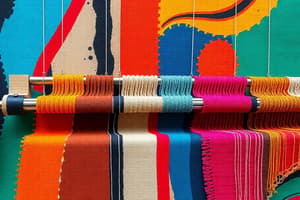Podcast
Questions and Answers
What is the fundamental unit of weft knitting structure?
What is the fundamental unit of weft knitting structure?
- Loop length (correct)
- Loop shape
- Yarn count
- Fabric density
Which factor does NOT affect the identical quality of two fabrics?
Which factor does NOT affect the identical quality of two fabrics?
- Length of yarn knitted into a stitch
- Take down tensions on the machine
- Yarn count
- Fabric dyeing method (correct)
How is loop length calculated?
How is loop length calculated?
- Total yarn used / number of layers
- Height of fabric / stitch density
- Course length / number of loops (correct)
- Width of fabric / number of stitches
What effect does very uneven yarn have on fabric appearance?
What effect does very uneven yarn have on fabric appearance?
What is the relationship between loop length and fabric tightness factor?
What is the relationship between loop length and fabric tightness factor?
Which of the following is NOT a characteristic used to determine fabric quality?
Which of the following is NOT a characteristic used to determine fabric quality?
What may indicate the presence of weak knots or bad splicing in knitted fabric?
What may indicate the presence of weak knots or bad splicing in knitted fabric?
Which parameter is NOT affected by loop length?
Which parameter is NOT affected by loop length?
What is the usual yarn tension for medium to fine gauge on a circular machine?
What is the usual yarn tension for medium to fine gauge on a circular machine?
What effect does high knitting tension have on loop length?
What effect does high knitting tension have on loop length?
Which feeding device achieves a more efficient yarn feeding process compared to the trip-tape method?
Which feeding device achieves a more efficient yarn feeding process compared to the trip-tape method?
What type of loop length variation occurs with fluctuating tension?
What type of loop length variation occurs with fluctuating tension?
Which statement about the yarn speed meter is correct?
Which statement about the yarn speed meter is correct?
What is the primary role of positive feeders in a circular knitting machine?
What is the primary role of positive feeders in a circular knitting machine?
How does the trip-tape positive feeder control yarn speed?
How does the trip-tape positive feeder control yarn speed?
What happens when yarn is wound with very low tension?
What happens when yarn is wound with very low tension?
Flashcards
Loop Length
Loop Length
The amount of yarn used to form one unit loop in knitted fabric, fundamental unit of weft knitting structure.
Loop Shape
Loop Shape
The shape of a loop in knitted fabric, affecting fabric dimensions.
Fabric Quality (Trade Interpretation)
Fabric Quality (Trade Interpretation)
Two fabrics are considered equal if their weight/area, course/inch, wales spacing, handles, and elastic properties are the same.
Fabric Quality Factors
Fabric Quality Factors
Signup and view all the flashcards
Uneven Yarn (Effect)
Uneven Yarn (Effect)
Signup and view all the flashcards
Loop Length (Parameters)
Loop Length (Parameters)
Signup and view all the flashcards
Loop Length Relationship
Loop Length Relationship
Signup and view all the flashcards
Factors Affecting Uneven Fabric Appearance
Factors Affecting Uneven Fabric Appearance
Signup and view all the flashcards
Yarn speed meter
Yarn speed meter
Signup and view all the flashcards
Yarn tension meter
Yarn tension meter
Signup and view all the flashcards
High knitting tension
High knitting tension
Signup and view all the flashcards
Fluctuating knitting tension
Fluctuating knitting tension
Signup and view all the flashcards
Low and even knitting tension
Low and even knitting tension
Signup and view all the flashcards
Trip-tape feeder
Trip-tape feeder
Signup and view all the flashcards
Multi-coil feeder
Multi-coil feeder
Signup and view all the flashcards
Positive feeder
Positive feeder
Signup and view all the flashcards
Study Notes
Knitting Technology: Quality Control
- Quality control in knitting involves a scientific approach to study knitted fabrics, particularly regarding garment size variations.
- Fundamental unit of weft knitting structure is loop length.
- Loop shape dictates fabric dimensions, influenced by yarn type, treatment, and fabric reception.
- Loop shape and loop length relationships can be expressed through equations.
Fabric Quality
- Fabric quality, according to general trade interpretation, is determined by:
- Identical weights per unit area
- Similar course per inch and wales spacing
- Identical handles
- Same elastic properties
- Fabrics are considered of identical quality when knitted from yarns of similar count and quality.
- Fabric constructional details must also be identical.
Factors Affecting Fabric Quality
- The only factors affecting identical fabric quality are machine take-down tensions.
- The length of yarn knitted into a stitch.
Yarn Quality & Fabric Defects
- Uneven yarn leads to cloudy fabric, holes, or cracks.
- Long periods of unevenness create stripes in the fabric.
- Dyeing or blending issues result in horizontal stripes.
- Large or weak knots or bad splicing cause yarn separation or breakage during knitting.
- Excessive yarn hairiness diffuses the stitch appearance and creates fluff.
Material Flow in Circular Knitting Machine
- Yarn storage on creels and delivery to needles are followed by stitch formation.
- Fabric take-down and temporary storage are part of the process.
- Key parameters include yarn tension, speed, course length, yarn evenness, needle condition, and cam temperature.
- Fabric quality and defects are monitored and recorded.
- Fabric tension is also a crucial parameter.
Loop Length
- Loop length, a basic component of knitted fabric, is the amount of yarn used to form a unit loop.
- Loop length is calculated as course length divided by the number of loops.
- Loop length affects various parameters including stitch length, tightness factor, fabric weight, width, panel length, and dimensional stability.
- Fabric thickness, weight, tightness factor, and stitch density are inversely proportional to loop length.
On-Machine Control
- Yarn Speed Meter Control: Checks yarn consumption speed and is useful for circular knitting machines with positive feed.
- Yarn speed is impacted by loop length, structure, and machine speed.
- Yarn Tension Meter Control: Measures yarn winding, unwinding, and knitting tension.
- Typical tension for medium to fine gauge circular machines is 2-5 gms.
- Knitting tension impacts loop length: high tension yields smaller loops, fluctuations lead to variations, and very low tension causes dropped stitches. Low and even tension produces good quality fabric.
- Yarn Length Meter: Measures yarn consumption for a given number of courses or machine revolutions.
- Results used to calculate loop length across machines of the same gauge.
Positive Feed Control
- Positive feeders regulate yarn knitting tension to desired values (low, even), leading to better fabric quality.
- Used in high-speed, non-jacquard machines.
- Types of Positive Feeders:
- Trip-tape positive feeder: simple, measured yarn feeding system, controlled by speed tape pulleys linked to the machine gearbox. The system uses two or three speed tapes. Suitable yarn tension is obtained when tape speed equals yarn speed.
- Multi-coil positive feeder: addresses the yarn slippage issue that occurs due to friction between yarn and tape in the trip tape positive feeder. The yarn is first fed to a pin wheel that has ten coils before it gets to the needles. This neutralizes the yarn tension variation from the cone, avoiding any slippage.
Yarn Tension Control
- Yarn unwinding method: Yarn tension varies from the first layer to the bottom due to the difference in unwinding conditions.
- Package size: Cone diameter and height affect winding tension.
- Unusual high package density: Leads to increased yarn friction and winding tension.
- Yarn faults: Sudden yarn diameter increase results in yarn tension changes within the knitting process.
- Spring wire tensioner: Affects V-bed machines during cam carriage direction changes.
Studying That Suits You
Use AI to generate personalized quizzes and flashcards to suit your learning preferences.




